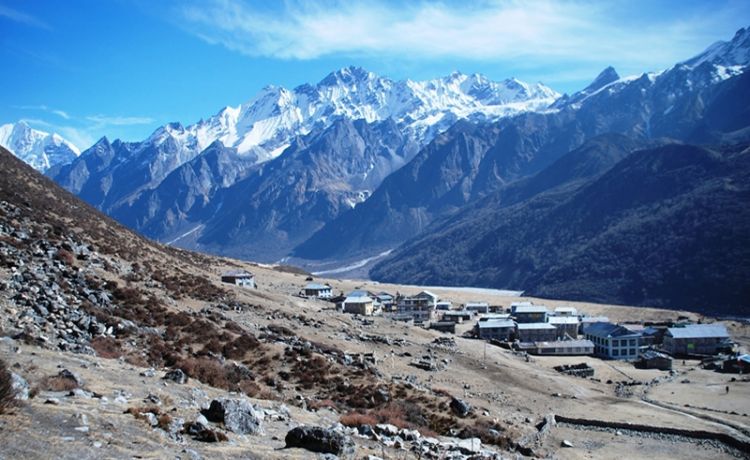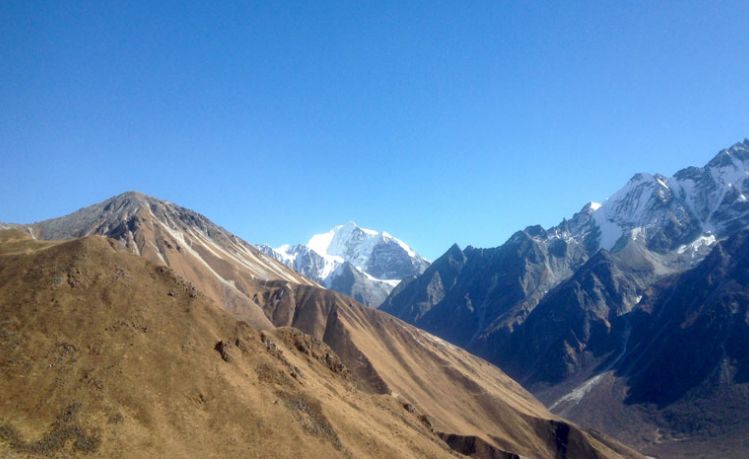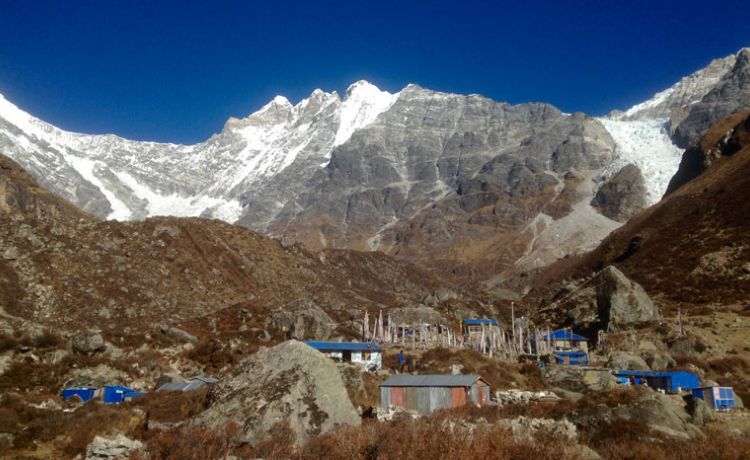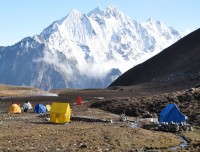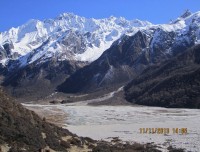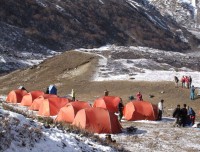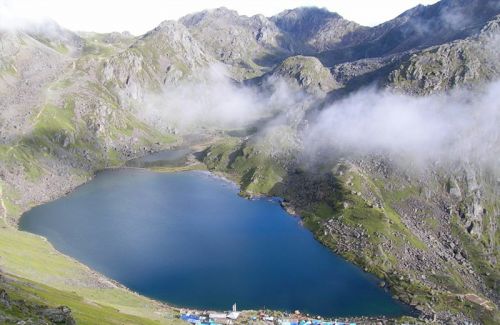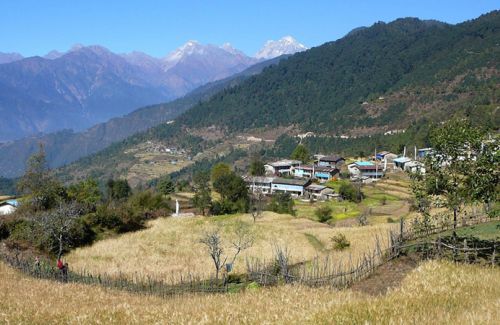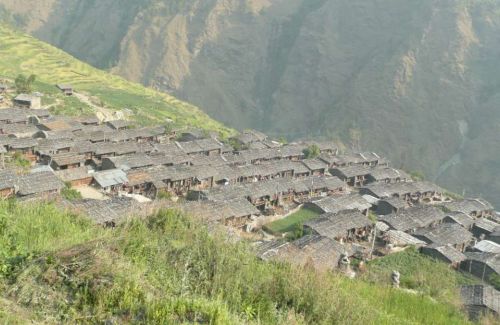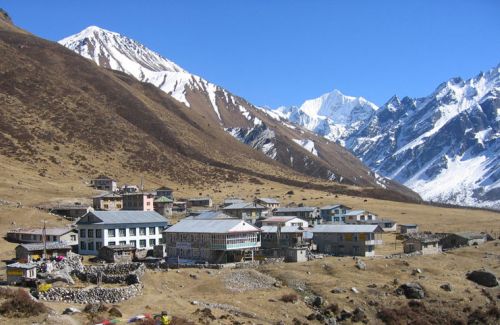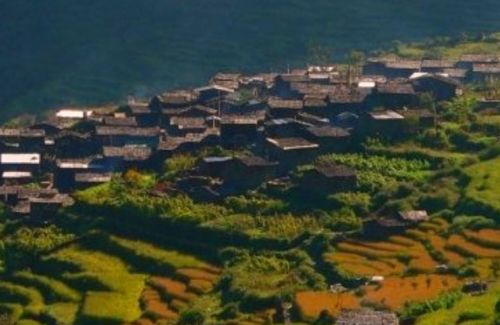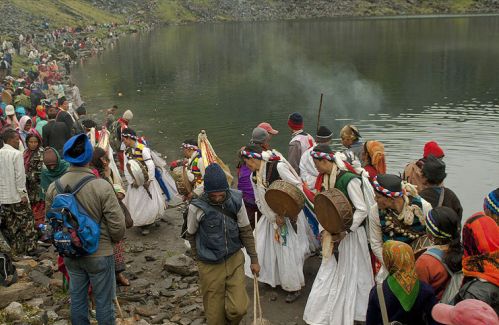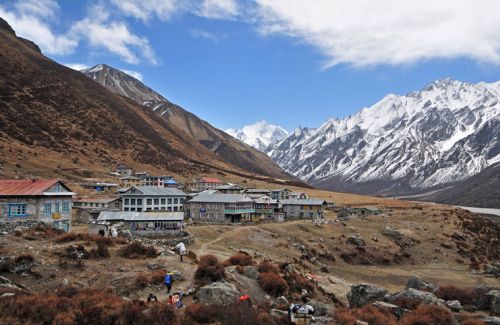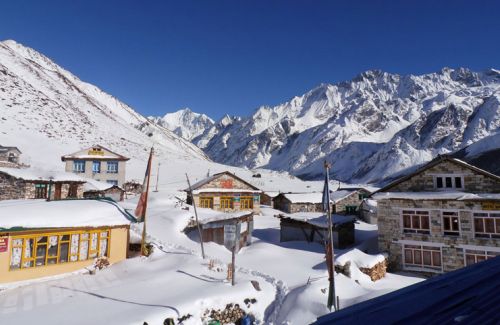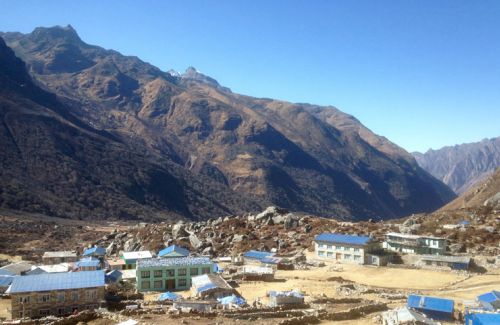Langtang Ganjala Pass Trek
- Duration14 Days
- Max. Altitude5,122 m
- Starts FromUSD 1375
Destination:Nepal
Trip Grade:Challenging (*****)
Meals:Breakfast + Lunch + Dinner
Transportation:Private Vehicle
Accommodation:Lodge
Trekking Region:Langtang Region
Show All
Langtang Ganjala Pass Trek is a challenging because of its difficult Ganja La Pass. One can see the rural life, Tibetan, Tamang, Sherpa villages, full of traditional heritages spread throughout in the sparsely populated area. We start the adventure with the day’s bus ride from Kathmandu to Syabrubenshi. The Ganja La Pass Trek usually begins from Syabrubenshi via the Kyangjing Gompa across the mighty Ganja La pass and ends at the Melamchipul Bazaar in the Himalayan region.
The Langtang Valley with Ganja La trek starts from Syabrubenshi and reaches to Langtang ,V - shaped valley, offers its natural wonders in its trails, with the rugged rock and snow capped mountains, grassy meadows full of Himalayan herbs and pine forests. The valley of the Langtang Khola has been a part of national park since the authorization in 1976, with 1700 sq.km, also encompasses the Upper Helambu, the Goshaikunda lake and the Jugal Himal in the east.
The people of this region would like to call themselves Sherpa, Bhotiyas, a group with Tibetan origins. The trail passes to the Kyangjing. From Kyanjing ,there are many things to be discovered. It is rewarding to spend few days in the Upper Langtang Valley. You can ascend to Tsergo Ri (5,033 m) , takes five hours over the high meadow of Yala, eastern Kyangjing. A day trip leads you to the cabins of Langsisa,nestled on the edge of the Langtang glacier. There is a legend about a big reddish rock at Langsisa, which is that color because a holy man living outside the valley lost his yak and trailed it to this place. The yak died here, however, and the lama, would like to hide it, skinned it and spread the skin on the rock to dry but the skin stuck and has remained there on the rock till this day.
The Ganjala Pass , one can enjoy the outstanding view of the pass and brace your body for the altitude adjustment . The Ganjala (5,200m) connects Kyangjing with Tarkeghyang in a line running north to south. With the Goshaikunda lake, it is the second crossing point between the Langtang Valley and Helambu. However, the Ganja La is far more wearisome alternative because of the high altitude and the difficult terrain. The name means “ Pass of the great snows” and the ganja la is place where there is frequent snowfall. The pass is usable from May until the beginning of November.
The descent from Ganja La in the south direction leads you over typical moraine fields. It is really fatiguing while crossing when there is the snow full in the gap between the rocks and crevasses. After four hours walks, we get the first Goths, a shelter for the herders. From there it is still one and half day quick walk to Tarkeghyang the path leads over the east side of mountain ranges.One needs full preparation and precautions about altitude sickness, trails and the upcoming challenges while on the trek. So, the guide with proper route knowledgeable , dedicated and responsible in each detailed thing is being recommended and Himkala Adventure is there to arrange everything to make your trip awesome.
Trip Highlights
- Full day sightseeing in UNESCO World Heritage Sites in Kathmandu
- Scenic drive from Kathmandu to Syabrubenshi and Melamchipul to Kathmandu
- Walking through the lovely forest of fir, birch, rhododendron and hamlock
- Passing through Langtang Khola, waterfalls, and big boulders
- Walking through open meadows
- Visiting cheese factory in Kyangjing
- Visit the Tibetan village in Langtang Valley
- Bio-diversity in Langtang National Park
- Rural life of Tibetan, Tamang and Sherpa villagers
- Rugged rock and snow capped mountains
- Grassy meadows full of Himalayan herbs
- Ganjala Pass and unbelievable views towards Helambu
Day to Day Itinerary
Day 01:Arrival in Kathmandu (1,350 m), Transfer to Hotel. Overnight at Hotel
Day 02:Kathmandu sightseeing & Trek Preparation. O/N at Hotel
Day 03:Drive from Kathmandu to Syabrubensi (1,503m), 145 km, 7 hrs. O/N at Guest House
Day 04:Trek from Syabrubenshi to Lama Hotel (2,410 m), 6 hrs. O/N at Guest House
Day 05:Trek from Lama Hotel to Langtang Village (3,430 m), 6 hrs. O/N at Guest House
Day 06:Trek from Langtang Village to Kyangjing Gompa (3,830 m), 4 hrs. O/N at Guest House
Day 07:Excursion to Tsergo Ri (4,984 m) and back to Kyangjing, 7-8 hrs. O/N at Guest House
Day 08:Trek from Kyangji to Ganja La Phedi (4300 m),5-6 hrs. O/N at Tented Camp
Day 09:Cross Ganja La pass (5,130 m) and trek to Keldang (4,270 m), 6-7 hrs. Tented Camp
Day 10:Trek from Keldang to Yak Kharka (4,000 m),5-6 hrs. Tented Camp
Day 11:Trek from Yak Kharka to Tarkeghyang(2,590 m), 5-6 hrs. O/N at Guest House
Day 12:Trek from Tarkeghyang to Sermathang (2,610 m), 3-4 hrs. O/N at Guest House
Day 13:Trek to Malemchipul Bazaar, 3-4 hrs, and drive to Kathmandu, 4-5 hrs. O/N at Hotel
Day 14:Departure to the International Airport
Cost Include
- Airport picks up & drops off by private tourist vehicle
- Three nights’ twin sharing basis accommodation at 3 star hotels in Kathmandu with Breakfast
- Guided city tour in Kathmandu by private tourist vehicle
- Full Board Meals(Breakfast + Lunch + Dinner) during the trek
- Lodges, Guesthouses accommodation during the trek
- Professional license holder English speaking City Tour Guide
- The required number of local staff and porters (2 Trekkers = 1 Porter)
- Food, accommodation, salary, insurance, equipment and medicine for all staff
- Langtang National Park Entry Permit and TIMS Card for trekking
- Down Jacket, Duffle bag and sleeping bag by Himkala Adventure if required
- Public transportation from Kathmandu to Sybrubeshi & Melamchi to Kathmandu
- Farewell Dinner in traditional Nepali restaurant with Cultural Show
- All equipments for tented camp for three nights
-
Government taxes, VAT & service charges
Cost Exclude
- Lunch and Dinner in Kathmandu
- Entrance fee in all monuments during tour
- Emergency Rescue and Evacuation cost
- Your travel insurance
- Nepal entry visa fee
- Personal expenses like: phone bill, laundry, hot shower, hot and cold drinks etc
- Personal trekking Equipment.
- Tips for trekking, tour staff and driver (Tipping is expected)
-
Any others expenses which are not mentioned on ‘Cost Includes' section
Detail Itinerary
Day 01Arrival in Kathmandu (1,350 m), Transfer to Hotel. Overnight at HotelThe representative from Himkala Adventure will be waiting for your arrival and after completion your custom formalities and issuing visa, you will be heartily welcomed and transferred to the hotel. You might have jet lag and necessarily should take rest. After you feel fresh, you could walk around Thamel. Overnight at Kathmandu
Day 02Kathmandu sightseeing & Trek Preparation. O/N at Hotel After our breakfast, we begin our guided city tour to the UNESCO World Heritage Sites at around 9 am. We will visit exquisite Stupas, and temples, courtyards, palaces. As Nepal is the repertoire of culture, you will be able to see such cultural practices, either in Stupas, the monks chanting and praying or the local Newar, the Bajrayana followers worshiping; In temples, the devotees are singing a religious song or lighting a lamp and offering with colors and flowers; In burning Ghat, the sons under the guidance of the priest, doing all the things have social value and significance. After the city tour we return back to hotel and we will brief you about the trek from tomorrow. Overnight at Kathmandu
Day 03Drive from Kathmandu to Syabrubensi (1,503m), 145 km, 7 hrs. O/N at Guest House After breakfast, we drive from Kathmandu to SyabriBenshi, which is 145 km winding roads the mountains view is awesome. It is 72 km from Kathmandu to Trishuli Bazaar with paved road, about 50 km from Trishuli to Dhunche rough road and 23 km from there to the destination can be tiring bus ride but we won’t have repentance as we savor the great panoramic view. The road from Dhunche descends gently at first, then series of steep loops to a bridge across the Bhote KOshi. Syabrubenshi has shops and lodges after the bridge. Overnight at SyabruBenshi
Day 04Trek from Syabrubenshi to Lama Hotel (2,410 m), 6 hrs. O/N at Guest House After breakfast, we start our trek to northward crossing the suspension bridge over the Bhote Koshi River. This is the pleasant trek through forest, stream and waterfalls and we reach to Village Inns and climb steep over the rocky ridge to Landslide lodge. We arrive at Bamboo. After crossing the suspension bridge over the Langtang Khola, we take the trail heading north following the bank of the Langtang Khola. We can see the massive boulder and the waterfall and finally arrive at Lama Hotel. Overnight at Lama Hotel
Day 05Trek from Lama Hotel to Langtang Village (3,430 m), 6 hrs. O/N at Guest House We continue our trek following the Langtang Khola, climbing steeply to Ghora Tabela, from where we can see the spectacular view of Langtang Lirung.Trekking permit is being checked here. From Ghora Tabela, the trail climbs more gradually to Langtang Village. The National Park headquarters is here. We can explore the monastery and the village with flat stone built Tibetan style houses. Overnight at Langtang Village
Day 06Trek from Langtang Village to Kyangjing Gompa (3,830 m), 4 hrs. O/N at Guest House After having breakfast at Langtang, we continue our trek through U shaped valley where the single track pierces the meadow, we continue on up a moraine to cross a tributary after another 2 hours. We find the vier further progressing with the impressive Langtang Himal. Another 20 minutes brings us to a trail fork. The left fork reaches to Kyangjin Gompa. Overnight at Kyangjin Gompa
Day 07Excursion to Tsergo Ri (4,984 m) and back to Kyangjing, 7-8 hrs. O/N at Guest House There are many things to explore around Kyangjing. The cheese factory, Langtang Glacier and the Kyangjing Monastery are worth seeing nearby. Besides this, we can hike early in the morning to Tsergo Ri at an elevation of (4,984 m). Before we reach to Tsergo Ri, We will hike to Kyangjin Ri viewpoint northeast of Kyangjin Gompa. Though this is challenging but from the top, it offers the 360 degrees view of Langtang, Yala Peak, Dorje Lakpa and Shishapangma. The prayer flag festooned summit, the best view point, Tsergo can be reached in two hours. After this we return back to Kyangjing Gompa. Overnight at Kyangjing Gompa
Day 08Trek from Kyangji to Ganja La Phedi (4300 m),5-6 hrs. O/N at Tented Camp After breakfast at Kyangjing, we descend down to Ganja La Phedi. Phedi is the base. So, it is very important to know that we spend one night underway before the top of the pass because the next day climb is a broad snowfield. So, we keep on going through snow moraines following the stream and the forest of juniper and the rhododendron. Phedi is also a pastureland. Overnight at Phedi
Day 09Cross Ganja La pass (5,130 m) and trek to Keldang (4,270 m), 6-7 hrs. Tented Camp We ascend through the steep and snowy region. It has rough, craggy, parts of the rocks where the prayer flags are found intertwined. The mountain view of Langtang Lirung, Shishapangma and others from the top is stupendous. The descent from the top is steep and slippery. We arrive at grassy meadows of Keldang via Yangri Khola. Overnight at Keldang
Day 10Trek from Keldang to Yak Kharka (4,000 m),5-6 hrs. Tented Camp After breakfast, we begin our trek through undulating trail along the ridges. We descend down to the pastureland. The picturesque view of yaks grazing on the meadows and the other side the blooming shrubs in dazzling colors with its intoxicated fragrance offers typical Himalayan experience. Overnight at Yak Kharka
Day 11Trek from Yak Kharka to Tarkeghyang(2,590 m), 5-6 hrs. O/N at Guest House After breakfast, we descend passing through pine and rhododendron forest. On the way, we see mighty Himalayas. This is the region inhabited by the Yak herders, based on the monastic community. The name “TarkeGhyang” means “Temple of the 100 horses”. Overnight at TarkeGhyang
Day 12Trek from Tarkeghyang to Sermathang (2,610 m), 3-4 hrs. O/N at Guest House After breakfast, we descend from TarkeGhyang, passing beautiful forest; arrive at Ganyul, the Sherpa settlement. After this, we descend and go over the ridge, cross the stream and reach to the crest. Another climb after the Chumnik village reaches to Sermathang. Sarmathang boasts with three large monasteries. These days, due to the construction of road nearby, the village has been segregated. Overnight at Sermathang
Day 13Trek to Malemchipul Bazaar, 3-4 hrs, and drive to Kathmandu, 4-5 hrs. O/N at Hotel After having breakfast, we follow the ridge all the way down to Melamchi Pul Bazaar. We pass many chortens in the beautifully located settlements of Nigale, Gyalsha, and Raithani Ghyang. From here, we pass the forest of chir pine and arrive at the lowlands inhabited by Brahmins and Chhetris. The trail further drops down to Dubhachaur (1,610 m) and ultimately brings us to the Suspension bridge of Indrawati River. We cross the bridge and reach to Melamchi Pul Bazaar (880 m). After this, we can drive to Kathmandu by public bus or private vehicle. Overnight at Kathmandu
Day 14Departure to the International Airport We transfer you to the Tribhuvan International Airport 3 hours prior to your scheduled flight. We would like to thank you joining Himkala Adventure to trek to Langtang Ganja La Pass and wish you have great journey to your onward destination. Namaste!!!
Trip FAQ
Himkala Adventure would like to answer all the queries about Langtang Ganjala Pass Trek for all curious travelers/trekkers in the world. As you are entirely from different geographical location, you could better to know everything about the treks from the beginning i.e. airport pick up till your departure like airport picks up, drops off, accommodation in city, in the trek, guide and porters, safety for the trekking, food and accommodation and some other things that you might face on the way. Hope our endeavor listing these questions answers will help you self informed.
This is simply the outlines of the services we offer but it may differ as per your requirement, number of trekkers. What we go through our conversation, we will manage the means of transportation, hotels in the city, accommodation in the trekking, numbers of porters etc. This is general idea about Langtang Ganjala Pass Trek before your trip and you become clearer about the trek. Please feel free to contact us to get more information about the trekking in the Himalayas of Nepal.
1) How is Langtang Ganjala Pass Trek in Nepal?
Langtang Ganjala Pass Trek traverses the famous Langtang region and the Ganja La pass(5122 m). Moreover, we also make an interesting excursion to Tserko Ri (5,000 m) which offers sweeping views of the Langtang Himalaya range.
2) What physical fitness do I need to book this trip?
Every trekking in the Himalayas of Nepal requires the certain level of physical and mental fitness. So, we advise you to be in good physical shape and able to feel comfortable while hiking up and down 7 to 12 miles per day on a trail carrying a day pack of about 10 pounds. Three things could make you confident enough for any trek you would like to do: aerobic, strength and mental.
Aerobic conditioning is important primarily because you will be trekking in thinner air, up to 40% less than at sea level. With good aerobic conditioning, you will be able to better metabolize whatever oxygen is available to you. You should plan on doing at least one hour of aerobic 3 /4 times per week for 1 month or more before your arrival in Nepal. Walking, jogging, cycling, hiking on valley floor to ridge line ascents with day back are some of the excellent forms of exercise, so long as you are strengthening leg muscles and building stamina. Speed is not the essence; stamina, confidence and continuity are. Do as much uphill as possible. If you live in flat area, go to the stadium and use the steps with your pack.
3) Do I really need to use guide to Langtang Ganjala Pass Trek?
You are advised to use Guide so that you could feel safer in the unknown area because the guide can tell you the possible danger as they have guided in this region since long. Most importantly, the Himalayan weather is really unpredictable and the Guide can help you to take proper shelter. Nest advantage to be with Guide is you get more knowledge about local culture and you could have easy access to interact with the local people. In 2014, the Nepal Government clearly has stated that the trekkers should have a guide but still it is not seemed in the practicality.
4) How do I find Himkala Adventure for my pick up at the airport?
Our representative from Himkala Adventure will display a small board (placard) of company or your name outside the airport terminal. You will be driven to the hotel by our tourist vehicle.
5) What sort of accommodation do I get in Kathmandu?
Normally we provide standard rooms with twin sharing accommodations at three star or similar category hotels in Kathmandu including breakfast. Accommodation in these cities can be upgraded as per your request. But some of our packages are sold without accommodation in the city.
6) How are tea house facilities during Langtang Ganjala Pass Trek?
Tea House is the combination of guest house, restaurant, and social hang out. Tea houses in Langtang Ganjala Pass Trek area are professional though they are simple but with neat and clean lodging offering fine views and plain but fresh and hygienic food with friendly atmosphere Most of the Tea Houses have running water facility. Many of them have hot water available for bathing. But we discourage our groups from using water heated by wood as lack of firewood in most villages is a big environmental concern in Nepal.
7) What sort of accommodation do I get in trekking?
Guesthouses/Tea Houses/Lodges provide twin sharing single and double rooms and occasionally a dormitory which is basically clean with a mattress and a quilt or blanket. Our company provides the sleeping bag if needed but we always recommend having your own sleeping equipments. You have to share the room with your group member or sometimes with unknown traveler. The toilet is always outside the room with basic facilities.
8) What sort of foods, water and drinks can I expect in trekking?
The foods in the Himalayas are very simple. There are mostly the family members themselves to cook and serve the meal. They are simply trained but experienced because they have been offering such services for many years in this busy route. The food is hygienic, fresh and delicious. We recommend you to drink mineral water or the boiled or using water purification pills or drops.
Most of the foods are cooked in the kitchen of tea houses. They serve you with different varieties of delicious Nepali and continental dishes. The most popular Nepali food is daal bhat (rice and lentils) with some mixed vegetable curry. Garlic soup is popular as it helps you with acclimatization. You could better be vegetarian in the mountains. All hotels in cities and guesthouses in trekking serve the vegetarian food. You can find all common types of drinks like hot chocolates, coffee, tea, hot lemon with honey, ginger tea, soft drinks etc. you will have your breakfast and dinner at the lodges where you will be staying and lunch somewhere on the way to your next destination.
9) What mode of transportation do I use?
We will provide the private transportation for Airport/Hotel/Airport pick up and drop and sightseeing in Kathmandu Valley. We use transportation as based on our cost inclusion section. The transportation varies depending on your requirements at the time of booking the trip.
10) What is the best season for this trekking?
The best season for Langtang Ganjala Pass Trek is spring (March to May) and autumn (September to December). These are the perfect time of the year for the breathtaking views of Himalayas with clear and sunny days. But the weather in the mountains is unpredictable.
11) What is the weather and temperature like during the trekking?
The climate in Nepal varies from place to place which can be categorized in different four main seasons. The main seasons in Nepal are spring (March to May), summer (June to August), autumn (September to November) & winter (December to February). The best season to travel in Nepal is autumn (September, October & November) & spring (March, April & May). Weather in the mountains is unpredictable. But the day temperature in Langtang Ganjala Pass Trek is comfortable.
12) Who will be guiding me during this trip?
We provide the professional government license holder English speaking trekking guides for our entire trekking trip. We can also provide French, Spanish, Japanese, German or Italian speaking guides as per your preference with extra payment but not guaranteed. All guides will be Nepali people who are carefully selected on the basis of their appropriate experience, leadership skills and personality. They are all trained from Nepal Academy of Tourism and Hotel Management, certified and approved by the Tourism Department of Nepal government. We provide a different city tour guide to guide you in UNESCO World Heritage Sites in Kathmandu. They are the professional license holder guide specialized in culture, history, geography, iconography, archeology and religion with good command over English. Tour guides are specialized in city tour and trekking guides are more in the hiking and trekking in the Himalayas.
13) What sort of experience do your guides have?
Our entire city tour guides have bachelors to Master Degree academic education along with many months tour guiding training from Nepal Academy of Tourism and Hotel Management, Rabi Bhawan, Kathmandu, Nepal. They are fluent in spoken languages and informative about the sites in many aspects. They are quite experienced and dedicated to their job and responsibilities.
Our entire trekking guides have minimum Intermediate to Master Degree academic education with trekking guide training from Nepal Academy of Tourism and Hotel Management, Rabi Bhawan, Kathmandu, Nepal. Many of them are from villages. As they are local, they know more about the routes, necessary precaution to be taken and so on. They have spent many years exploring many parts of the country. They are trained in first aid and able to handle any situation easily. They speak good English and make you know about the places you visit.
14) May I charge my electronic gadgets during Langtang Ganjala Pass trek?
Most of the places in your tea houses have charging facilities. You can charge your devices by paying some extra money. It’s good if you bring TWO or THREE pin travel adapter and put your gadgets at warm place at night.
15) How much additional money is required for this trip?
It’s a very personal question as expenses depend on habit. Normally, in Kathmandu you can allocate about USD 10 to 15 per person per lunch or dinner. USD 10 to USD 15 per person per day will be sufficient to buy bottles of water, chocolates, pay for a hot shower during the trekking. Other personal expenses will be your own calculation.
16) What is the social and environmental responsibility of Himkala Adventure for this trip?
The situation of environment in Nepal is in considerable stage due to so many factors caused by global warming, human activities, and adverse effects of natural incidents. Nepal is in between two giant countries like China and Nepal. The ozone layer is depleting and the atmosphere is getting heated. So, its direct effect is to the Himalayas that the snow is melting day by day and the sea level is rising. It is due to population growth, people are clearing the forest and the soil is being eroded. As a part of society, and our trekking related activities are directly concerned with the social and environmental things. We are very conscious not litter in the open spaces, to manage garbage properly and make local people aware in this campaign. We are working together with other companies and taking these issues seriously.
17) What is the minimum number requirement for this trip?
We operate individual trip to the group joining trips for Langtang Ganjala Pass Trek. If you want to do any private trip we are ready to organize for solo traveler as well with some additional charges.
18) Are there communication or internet services during Langtang Ganjala Pass Trek?
All our guides carry the local mobile phone. You can use his mobile phone to make any local or international call from trekking trails by paying him directly. You can even pass him number to be connected with your family or friends. We highly recommend taking local SIM card for call and internet services during trekking. Local SIM cards are easily available in many stores and at airport as well. You need to provide two copies of your photographs and your passport copy to get local SIM CARDS of NCELL & NTC (only these two companies provide telephone services in Nepal.
19) May I get chances for shower during Langtang Ganjala Pass Trek?
Most of the guesthouse provides hot shower with some extra cost. In few places, bucket water will be provided for the shower.
20) May I add extra days in trekking?
Yes. You can customize the trek as you would want. We are flexible while preparing the itinerary and you could lengthen or shorten it as per your requirement.
21) What happens in case of emergency?
Himkala Adventure has prepared for any emergency situation and knows how to handle it. Our guides are trained in first aid and can deal with most of the basic ailments that occur during the trek. Every client should have his own insurance before coming to Nepal for the case of emergency.
22) Do I need to have insurance for this trip?
We request you to have a travel-insurance policy to cover theft, loss, medical problem & emergency helicopter evacuation from high altitude places before coming Nepal. Choose a policy to cover your emergency high altitude helicopter evacuation with all medical insurances for trekking in high altitude in the Himalayas of Nepal. Your travel insurance is always needed before going in any high altitude trekking. Please check your travel insurance policy which doesn’t exclude mountaineering or alpinism. Although you will not be engaging in these activities in your trekking, you might have problem convincing the insurance company of this fact. Rescue insurance need to cover an emergency helicopter evacuation or a charted flight from remote mountain trails of Nepal as well as international medical evacuation. A helicopter evacuation might cost US$ 2500 to US$10000 depending on the places. So that travel insurance to cover all above is must to travel in the high Himalayas of Nepal.
23) What type of shoes should I wear during Langtang Ganjala Pass Trek?
You could better have carefully chosen hiking boots with extra laces which should be kind of strong, well-made but light boots for Langtang Ganjala Pass Trek. Shoes and boots are best to buy before arriving in Nepal. We advise you to wear your new shoes for sometime before trek so that you could feel well habituated on the newer trail for your feet.
24) Can I use credit cards in the Langtang Ganjala Pass Trek route?
No, you can use only in the cities like Kathmandu. So, it is better you to make change in Kathmandu. When you are out of city, all you need is cash, better to have small notes. Please change the currency in local Nepali rupees before you go to the mountains.
25) Do I need to tip my guide and porter? How much would that be?
Tipping is not mandatory, neither it is right to ask by anyone but it is a way of showing gratitude after taking service. The level of tip also shows how satisfy you are from the team that you had been during your tour/trek.
However, we recommend you to spend minimum 10% of your total trip cost for tipping entire local staffs, the ratio of tipping guide and porter will be given to you at the pre-trip meeting in Kathmandu before starting the trek.
26) How is Camping Trek to Langtang Ganjala Pass being operated?
Camping trek is fully organized and supported, with a team of guides, cooks, and porters to accompany you. Our porters carry all the trekking gear, food, fuel and personal belongings. Our cooks prepare hot meals. Trekkers need only carry a small bag as required for the day. At night, tents for dining, sleeping and ablutions tents are provided and set up, also mattresses and down-filled sleeping bags, tables and seating.
In a typical camping trek, we start the day around 6 a.m. with a cup of hot tea. You are then provided with a bowl of warm water for washing. Then trekkers enjoy breakfast before leaving camp. The trek begins around 7.30 - 8 a.m.
Trekkers can set their pace for pausing and sightseeing and the walk to the lunch spot will normally take 3 hours. On arrival, you are served hot lunch. In the afternoon, after walking for another 3 to 4 hours, you arrive at the next camp around 5 p.m. Tea & snacks are served while our staff readies the camp. Dinner time is around 6/7 p.m. in the dining tent, lit with lanterns and comfortably furnished. The food is healthy, wholesome and hygienically prepared.
Trip Note
Cost:
The cost of trip varies according to the number of travelers in the group, the category of the Hotel, mode of the transportation and any kind of changes (if there is). So, if you would let us know all of these above mentioned things, then we could quote you the exact price.
Essential documents:
You are requested to send the following documents after you confirm or book the trip with Himkala Adventure:
A copy of your passport and travel/health insurance documents with contact details, three passport size photos.
It is advised to maintain a separate photocopy of all important documents including traveler’s cheques, bank/ATM card, contact numbers, international flight tickets, and emergency contact numbers.
Weather:
The main trekking season in Nepal is from October to December and March to May. The day temperature for walking in Langtang Ganjala Pass is comfortable. The sky is clear although there is snow and rainfall occasionally. It is about 10 degree centigrade at the height of 3,600 m and increasingly lower, the higher we go.
Nepal Strikes:
There is much more progress in the political scenario in Nepal and we assure you that travelling in Nepal is safe. But there may be Bandha (wide transport strikes) at a very short notice. The shuttle bus is in operation by Nepal Tourism Board and the Nepal Tourist Police in conjunction with the Himalayan Rescue Association from domestic and international terminal to the various hotels in Kathmandu. The service costs 300 rupees per person.
Itinerary Disclaimer:
Himkala has thoughtfully designed all the itineraries but our itineraries are updated for the betterment on the basis of our past travelers’ comments and our own research. In case you find changes in the itinerary you printed and the upgraded one does not affect your trip. Please note that some changes may occur in our itineraries due to bad weather and common seasonal changes to timetables and transport routes.
Physical Rating:
Your trip will be meaningful if you could find yourself fit and fine. You will be walking up to 5,122 m from the sea level. As the geographical region varies, there is a temperature variation as well. So, we advise you to undertake regular physical exercise, jogging, hiking, riding, ascending and descending the long stairs etc. Precautions and acclimatization are undertaken but be aware of the effects altitudes can have.
Group Size:
Himkala Adventure organizes solo to group travelers. Our group trips are designed for sharing accommodation and there is no single supplement. Single travelers share with the same gender from twin to multi-share in an accommodation. You are requested to have mutual understanding in between the fellow travelers who have joined from the different parts of the world. Please remember that you have great responsibilities in the group. If you are requested to be at a particular place at a certain time, make sure that you have been there at a time. It is much more pleasing sharing experiences and traveling together.
Accommodation and Meals:
Accommodation and Foods in the Himalayan region of Nepal cannot be compared with any developed countries in the world. We know that you might not have experienced such things before but you should take it easy. Accommodations at local lodges are simple but clean and comfortable. The food is plain. Toilets and washing facilities are shared and rudimentary. In high altitude regions, there are very few tea houses and one has to be happy to share in simple dormitories without electricity, without running water. Hot shower means a bucket of hot water upon our request.
Money Matters:
Please note that most establishments in Asia will not accept foreign currency notes that are old, torn or faded and they can be very difficult to exchange or extra fees added when exchanging at banks. Please ensure that you have new, clean notes.
The official currency of Nepal is the Nepali Rupee (NPR). ATMs can be found only in major cities of Nepal like Kathmandu, Pokhara, Chitwan, Bhaktapur etc. The government of Nepal has banned the import, export and use of 500 and 1000 Indian rupee notes in Nepal. You make sure that you won’t carry these notes upon arrival in Nepal, otherwise they are confiscated and you may be fined.
Please make sure that the foreign currency notes that you have are new and clean notes because old, torn or faded foreign currency notes in Nepal are very difficult to exchange or extra fees added when exchanging at banks.
While travelers cheques have security advantages exchanging them can be a lengthy process, commissions can be high (up to 10%) and they can be difficult to change in rural areas, on weekends and public holidays. If you choose to bring travelers’ cheques, make sure they are a major brand and major currency.
Tipping:
Tipping is not mandatory. It is not anyone’s right asking for tips but if you are happy with the service, you could tip the staffs. It is entirely a personal preference. Tipping could be significant to them who took take great care of you in your traveling period. Himkala recommends that you could tip any intended recipient by any member of the group than collected and passed on by the group leader.
Note: Please do not tip with coins or dirty and ripped notes. This is culturally taken as an insult.
Local Dress in Nepal:
Nudity is a sensitive issue in Nepal. Women should avoid wearing shorts and sleeveless tops in public places where this might be seen as inappropriate. Remove shoes before entering certain holy places. Non-Hindus are not permitted in some temples.
Feedback:
Your feedback will be the great guidance to meet our target and to bring improvement in our service. What and how have you experienced with Himkala Adventure and our staff? Please write, we will read it carefully. One cannot see his/her shortcomings that are lying with them. Someone should point it out. We are always eager to hear from you.
Trip Info
- Communications and Updates
- Conservation
- Cross Cultural Issues
- Essential Do’s and Don’ts
- Foot Ware/Foot Care
- Health and Fitness
- Himkala Crews
- Hypothermia
- Safety and Security
- Travel Insurance and Evacuation
- Trip FAQs
- Washing and Shower
- Water/Food and Nutrition
- Trip Grading
- Weather
- Accommodation/Shelter
- Altitude Sickness
- Equipment List
